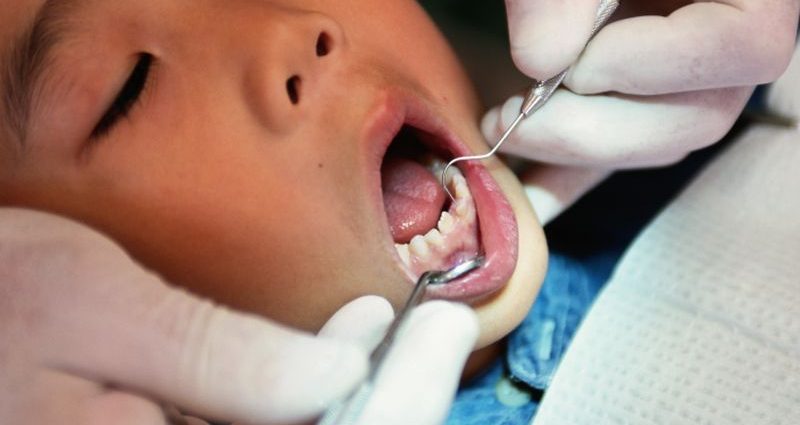THURSDAY, Jan. 20, 2022 (HealthDay News) — If the sound of a dental drill sends shivers up your spine, you’re likely in good company: Finnish researchers say that one of every two adults fear the dentist at least a little, while one in 10 are very afraid.
But the researchers added that a local dentistry program has found a novel way to turn screams into smiles, by exposing patients as young as 2 to a series of desensitizing exams that pair dental care with a wide variety of anxiety-reducing techniques.
The program is based in the small central Finland city of Oulu. Oulu is home to about 200,000 Finns, and now the “Clinic for Fearful Dental Patients.”
Patients at the clinic are treated by three dentists “who are interested in treating fearful patients and have taken courses on the topic,” explained study author Vuokko Anttonen. Two are clinical practitioners who lecture students on the topic of dental fear; a third is a hypnotherapist.
Anttonen is a professor of cariology, endodontology and pediatric dentistry with the research unit of oral health sciences at the University of Oulu. For the study, she and her colleagues tracked the experiences of 152 patients under the clinic’s care between 2000 and 2006.
Some were adults (oldest was 51). But nearly 80% were between the ages of 2 and 10. All needed dental work. Yet all had been referred to the dental fear clinic by a primary oral health care clinic, after several attempts to provide treatment failed due to dental fear.
That included: a generalized fear of doctors; a specific fear of dental care; a fear of needles; a fear of specific dental procedures; and/or an uncontrollable gagging reflex.
In the report published online recently in BMC Oral Health, the investigators highlighted the clinic’s two-pronged approach, tailored to the nature of each patient’s particular fear.
The first entails a battery of psychological techniques designed to promote calm and to “strengthen the patient’s sense of control and trust,” explained Anttonen. That’s achieved, she said, through a bedside manner that places a premium on transparency, so that even very young patients can understand the dental process and agree to proceed.
Clinic dentists then try to cajole, distract, relax and desensitize their patient. Sometimes that’s through classic positive reinforcement, such as congratulating a child for “making it” through a procedure. Sometimes hypnotherapy is deemed helpful.
The second approach: pain control.
“Pain control is important,” stressed Anttonen. And the various tools at the clinic’s disposal include conscious oral sedation, nitrous oxide sedation or even general anesthesia.
When the study ended, dental fears were reassessed, with success defined as having no reported sign of dental fear and no continued need for sedation or general anesthesia.
The team concluded in a prior study that, by 2006, the clinic relieved dental fears in roughly seven of 10 patients, who could then go back to any dentist they choose.
But the investigators continued to track all 152 patients for up to 10 more years, to see how often they actually did so.
The researchers found that clinic patients collectively underwent nearly 2,600 dental procedures by 2016, at which point the average patient age was nearly 22.
But the findings showed that younger patients — children under 10 when treated at the dental fear clinic — ended up visiting regular dentists during the ensuing decade more than twice as often as their older peers (an overall average of nine visits versus four visits). As a result, younger clinic patients also ended up needing significantly less emergency dental care.
“Fear is normal, and can be a positive thing protecting a person from harming him/herself,” Anttonen said. “But if fear…is so strong that it hinders a person from going to the dentist, it is harmful, and should be dealt with.”
Jane Grover is senior director of the Council on Advocacy for Access and Prevention at the American Dental Association (ADA). She noted that if the ultimate goal is to prevent adult fear of dentists, it’s best to start early.
“Fear comes from many factors, including a hesitancy of the unknown,” Grover said. “When young children have a fun initial dental visit — to get their teeth counted [or] squirt the air/water syringe while riding up and down in the dental chair — or accompany their parents/caregivers to a dental appointment ideally for a preventive procedure, such as a cleaning, they experience the sights and sounds of a dental office, which reduces anxiety in their future appointments.”
And that is why “the ADA has long had policy on the ‘Age One’ dental visit, which allows a wonderful opportunity to engage a parent or caregiver on oral health topics, such as brushing, nutritional guidance and topical fluoride benefits,” Grover added.
“We work collaboratively with the American Academy of Pediatric Dentistry, who support a dental visit by age 1 or whenever the first tooth erupts in the mouth,” she noted.
More information
There’s more on tips for alleviating dental fears at the American Dental Association.
SOURCES: Vuokko Anttonen, PhD, DDS, professor, department of cariology, endodontology, and pediatric dentistry, research unit of oral health sciences, University of Oulu, Finland; Jane Grover, DDS, MPH, senior director, Council on Advocacy for Access and Prevention, American Dental Association; BMC Oral Health, Oct. 13, 2021, online
Copyright © 2026 HealthDay. All rights reserved.

